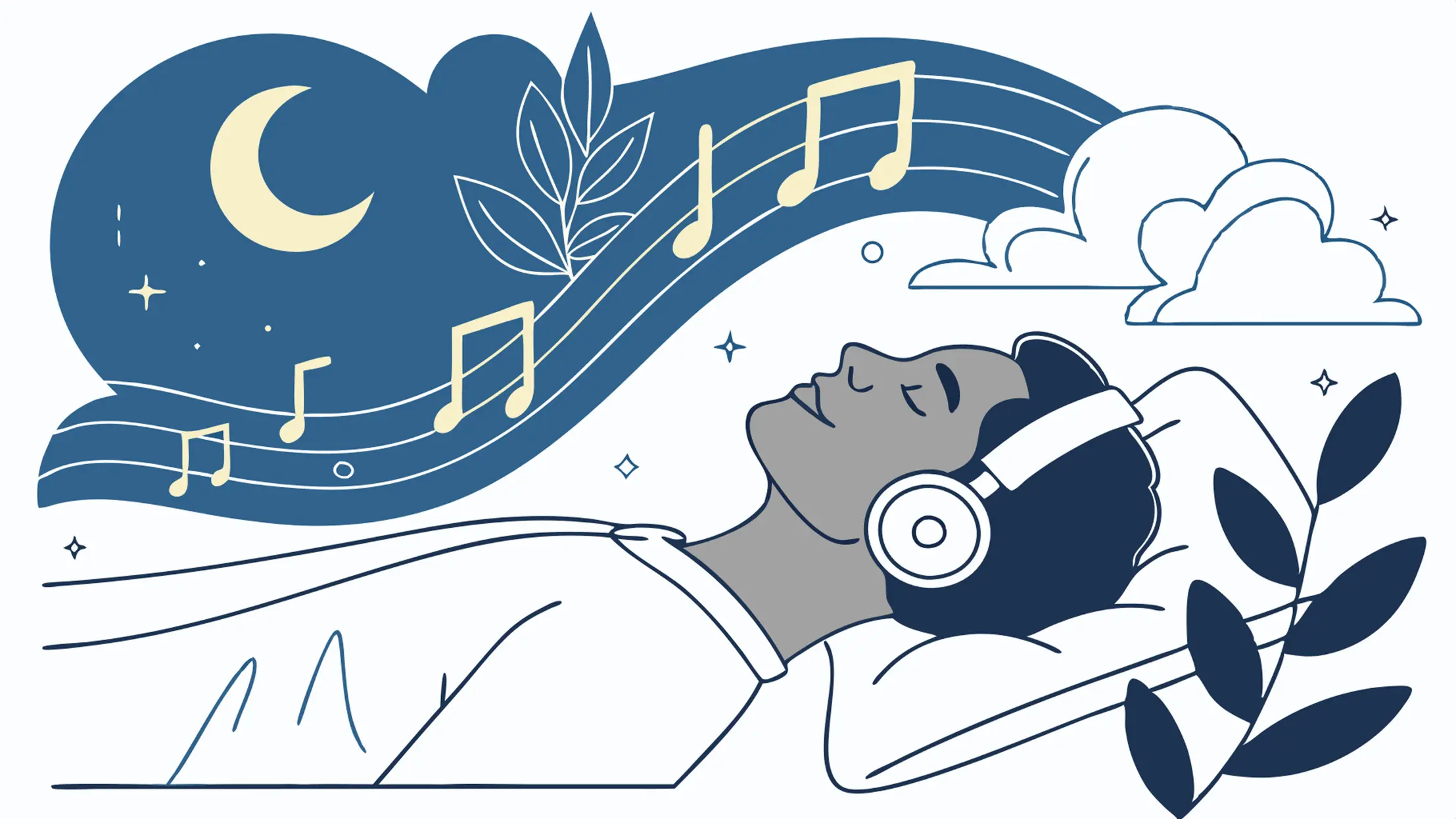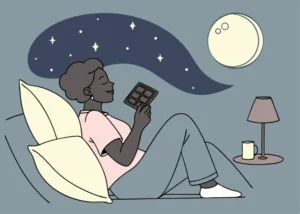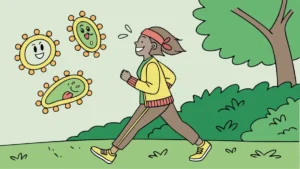Getting good sleep has become harder in our busy world. Many people rely on pills, but research shows that sleeping music for deep sleeping offers a natural way to sleep better. From classical songs to ocean waves, the right sounds can help you sleep deeper and wake up feeling refreshed.
How Sleep Music Works: The Science Behind Better Sleep
Scientific studies prove that music has a powerful effect on how we sleep. When you listen to the right music designed for deep rest, your body goes through changes that help you sleep better and deeper.
Music helps reduce the time you spend in light sleep while increasing deep sleep stages. This happens because music affects your hormones, including cortisol (the stress hormone), creating better conditions for deep rest.
Listening to relaxing melodies before sleep also releases dopamine, which makes you feel good at bedtime and can help manage pain that might keep you awake. Music calms your nervous system, which controls automatic body functions like breathing and heart rate.
Research shows that this type of music leads to slower breathing, lower heart rate, and reduced blood pressure. These changes create the perfect environment for falling into deep sleep. One study found that people who listened to music before napping had better sleep quality and fell asleep faster.
Understanding how basic fatigue management works can help you see why sleep music is so effective at fighting tiredness and improving energy levels.
Types of Sleep Music That Really Work
Classical Music for Deep Sleeping Music
Classical music is one of the most studied types of sleeping music for deep sleep. A major study with 94 students who had trouble sleeping found amazing results. Those who listened to relaxing classical music for 45 minutes before bed for three weeks slept much better and fell asleep faster.
The best classical music for sleep has these features:
- 60-80 beats per minute (matching your resting heart rate)
- Few or no drums
- Smooth, flowing melodies
- No sudden loud or quiet parts

Ambient and Meditation Music
Deep sleep meditation music is specially made to calm both your mind and body. Research on over 225,000 sleep tracks on Spotify showed that ambient music works great for sleep because it has low energy and is mostly instrumental.
Studies found that college students who used sleep ambient music for just one week had better sleep quality, fell asleep faster, and felt less anxious and depressed. The benefits got even better after three weeks of regular use.
If you’re dealing with ongoing tiredness, learning about chronic pain and fatigue can help you understand how sleep music fits into a bigger picture of wellness.
Special Frequency Music
432 Hz Music
One of the most interesting discoveries in sleep research involves 432 Hz music. Studies show that listening to 432 Hz music for 15-20 minutes before bed helps you fall asleep faster and spend more time in deep sleep stages.
This special frequency helps rebalance your body and brain, creating calming brain waves and reducing stress hormones. People in studies reported falling asleep quicker and having more restful sleep.
Delta Wave Music
Delta wave music uses frequencies between 0.5-4 Hz, which match your brain’s natural deep sleep patterns. This type of music for deep sleep helps guide your brain into the deepest, most restorative sleep stages more easily.
Binaural Beats
Binaural beats use special frequency combinations played through headphones to influence your brain waves. When you listen to binaural beats at 3.2 Hz, they create delta brain waves that are perfect for overcoming insomnia and promoting deep sleep.
These beats help reduce stress and anxiety while helping your brain sync with rhythmic sounds that promote sleep. This makes them more effective than regular music alone.
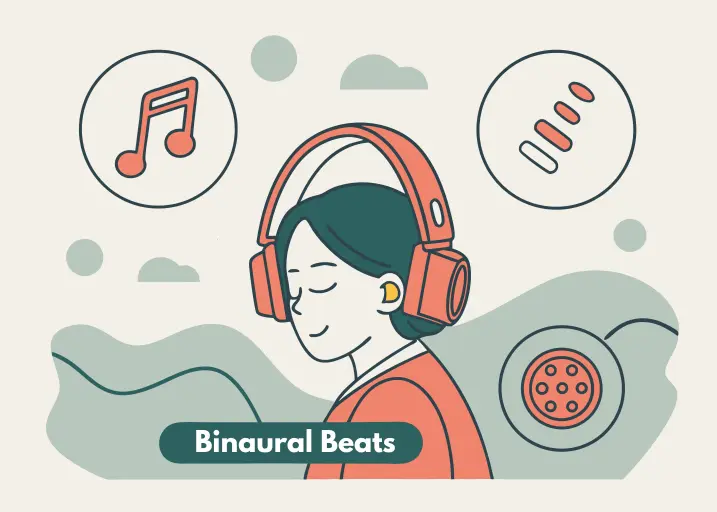
Nature Sounds for Better Sleep
Ocean Sounds
Ocean sounds for deep sleep are among the most effective natural sleep aids. Your brain processes ocean sounds as non-threatening because they have slow, gradual volume changes instead of sudden, jarring noises.
Research shows that people who listen to ocean sounds sleep deeper, wake up less often, and fall back asleep easier when briefly disturbed. The rhythmic waves create a hypnotic effect that masks disruptive noises while promoting relaxation.
Rain and Forest Sounds
Rain sounds, especially those recorded in natural forests, work as effective white noise that blocks out distracting sounds while creating a peaceful background. The gentle, consistent nature of rainfall provides soothing ambiance that many find perfect for both falling asleep and staying asleep.
Forest sounds, including gentle waterfalls and bird songs, have been extensively studied for their sleep benefits. Research consistently shows that nature sounds are often more effective than traditional relaxing music, likely because of our natural connection to these environments.

ASMR Sleep Sounds
ASMR (Autonomous Sensory Meridian Response) has become a powerful tool for promoting sleep. ASMR triggers specific body responses, including tingling sensations and deep relaxation, that can significantly improve sleep quality.
The science behind ASMR’s sleep benefits involves reducing cortisol levels and increasing serotonin release. These brain chemical changes create optimal conditions for falling asleep and staying asleep. Studies show that people who experience ASMR can lower their heart rates more effectively than those who don’t.
Popular ASMR sleep triggers include:
- Whispering: Soft-spoken words that create calm
- Tapping: Gentle rhythmic sounds on surfaces
- Page turning: Crisp, delicate sounds that focus the mind
- Personal attention scenarios: Simulated one-on-one care
- Crinkling sounds: Subtle audio textures from paper or foil
- Hair brushing: Gentle sounds that bring comfort
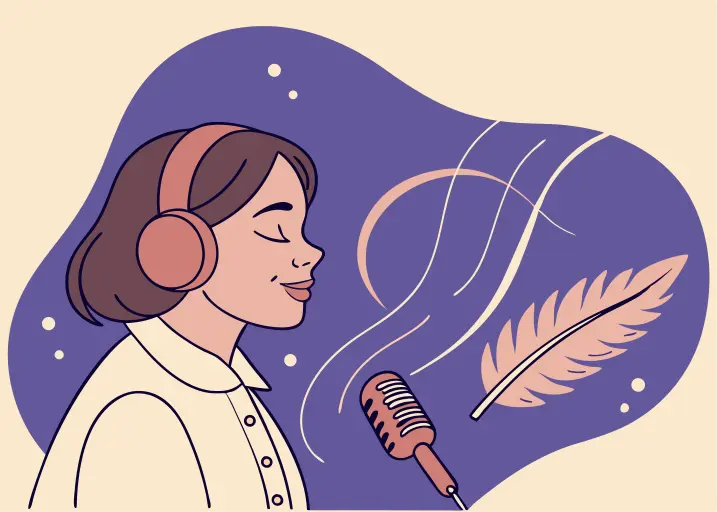
How to Use Sleep Music Effectively
Tempo and Musical Features
Research has identified specific musical characteristics that work best for sleep. The ideal tempo for relaxing sleep music and deep sleep music is between 60-80 beats per minute, which matches your resting heart rate.
Studies looking at thousands of sleep tracks show the main features of music that works well for sleep:
- Simple, repetitive rhythms and melodies
- Minimal volume changes
- No percussive instruments
- Limited or no vocals
- High instrumental and acoustic qualities
Volume and Environment
Research on music volume and relaxation shows that soft music (60-70 decibels) works much better for relaxation than medium (70-80 dB) or loud (80-90 dB) volumes. This preference was consistent across different age groups.
For the best listening setup:
- Keep volume between 60-70 decibels
- Use consistent volume throughout tracks
- Use comfortable headphones or speakers positioned away from the bed
- Avoid sudden volume changes
Timing and Duration
Studies show that listening to sleep music for 15-45 minutes before bedtime provides the best benefits. This timeframe allows the music to influence your body’s processes without becoming a distraction when you’re actually trying to fall asleep.
For maximum effectiveness, make sleep music part of a consistent bedtime routine. Research shows that benefits build up over time, with significant improvements often appearing after 2-3 weeks of regular use.
Understanding causes of low energy can help you see how poor sleep contributes to daytime fatigue and why quality rest is so important.
Creating Your Personal Sleep Playlist
Choosing the Right Genres
While everyone has different preferences, research provides clear guidance on effective genre selection. Analysis of global sleep music preferences shows that successful sleep playlists often include multiple genres rather than focusing on just one style.
Popular evidence-based genre choices include:
- Classical: Bach, Mozart, Chopin compositions
- Contemporary ambient: Brian Eno, modern instrumental artists
- Nature sounds: Ocean waves, rain, forest ambiance
- Lo-fi music: Gentle electronic compositions with minimal complexity
- Acoustic instrumental: Guitar, piano, string arrangements
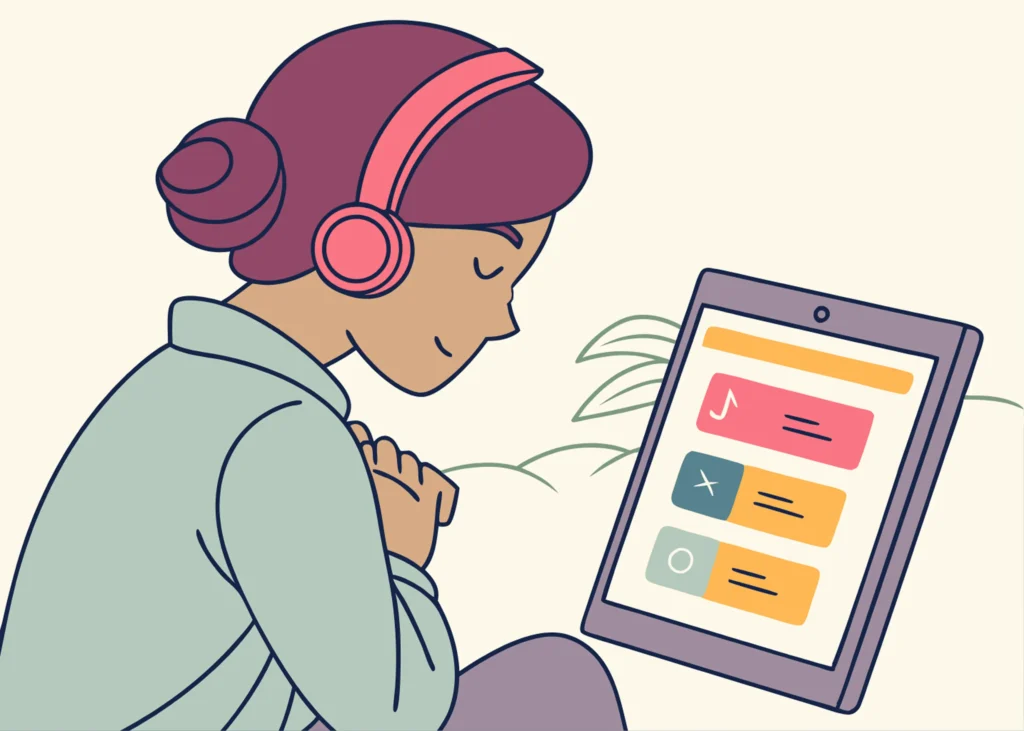
Avoiding Common Mistakes
Research has identified several characteristics that can make sleep music less effective. Surprisingly, some instrumental music can actually be more disruptive than music with lyrics, especially when it creates “earworms” – songs that replay in your mind and disrupt sleep.
Elements to avoid in sleep playlists:
- Tempo above 80 beats per minute
- Songs that bring up strong emotions or vivid memories
- Tracks with sudden volume changes
- Music with complex rhythms or intricate melodies
- Familiar songs that might make your mind more active
Testing and Personalizing
Creating an effective sleep playlist requires personal experimentation and gradual improvement. Research suggests starting with scientifically-proven categories and then customizing based on how you respond.
Follow this systematic approach:
- Begin with proven categories (classical, ambient, nature sounds)
- Test each category for 1-2 weeks while monitoring sleep quality
- Note which styles help you fall asleep faster and sleep deeper
- Gradually refine selections based on personal response
- Create multiple playlists for different situations or moods
Color Noise Options for Deep Sleep
Color noise represents another scientifically-supported category for sleep enhancement. Each type offers distinct characteristics that can benefit different aspects of sleep quality.
White noise contains all audible frequencies in equal parts, creating a consistent sound that effectively masks environmental disturbances.
Pink noise provides a gentler alternative, using deeper sounds and lower frequencies to create a more soothing experience.
Brown noise produces even deeper, bass-like tones that many find more relaxing.
A rising favorite is green noise for sleep, which mimics natural environments like waterfalls, rivers, or wind. Its mid-frequency tones feel more organic and calming than traditional noise types. Many users find it the most relaxing and natural-sounding option.
Studies consistently show that color noise can improve sleep efficiency and reduce night wakings. The masking effect of consistent background noise helps prevent environmental sounds from triggering your brain’s threat-detection systems.
Benefits of different color noise types:
- White noise: Comprehensive frequency masking, proven effective for babies and adults
- Pink noise: Enhanced deep sleep promotion, gentler frequency profile
- Brown noise: Maximum low-frequency emphasis, ideal for those preferring bass-heavy sounds
Scientific Evidence and Results
Multiple studies using objective sleep measurement tools have documented the specific benefits of sleep music. Sleep lab studies show that music listeners spend less time in light sleep and more time in deep sleep phases. These changes represent significant improvements in sleep structure that directly impact rest quality and daytime functioning.
Research also shows measurable improvements in sleep onset latency – the time required to fall asleep. Studies consistently show reductions in sleep onset time ranging from 6-13 minutes after incorporating sleep music, compared to baseline measurements of 27-69 minutes.
Long-term studies reveal that sleep music benefits extend beyond immediate sleep improvements. Research participants show sustained reductions in anxiety and depression symptoms, improved mood regulation, and better overall sleep quality after several weeks of consistent use.
If you’re struggling with daytime tiredness despite getting enough sleep, learning about why you might feel tired after 8 hours sleep can provide additional insights.
Technology and Implementation
Modern technology offers numerous options for implementing sleep music effectively. Streaming platforms provide access to specially curated sleep playlists, while dedicated apps offer features like gradual volume reduction and automatic shutoff timers.
Recommended implementation approaches:
- Use smartphone apps with sleep-specific features
- Consider dedicated white noise machines for consistent delivery
- Use Bluetooth speakers positioned at appropriate distance from the bed
- Try headphones for shared sleeping spaces (with comfort considerations)
Sleep music achieves maximum effectiveness when combined with comprehensive sleep hygiene practices. Research indicates that music works best with other evidence-based sleep interventions, including consistent sleep schedules, optimized sleep environments, and relaxation techniques.
The most successful implementations involve gradual introduction of sleep music alongside other beneficial practices. This approach allows you to identify which combinations provide optimal results while building sustainable bedtime routines that support long-term sleep health.
For those dealing with energy issues during the day, exploring natural electrolytes for energy and understanding the benefits of hydration for energy can complement your sleep improvement efforts.
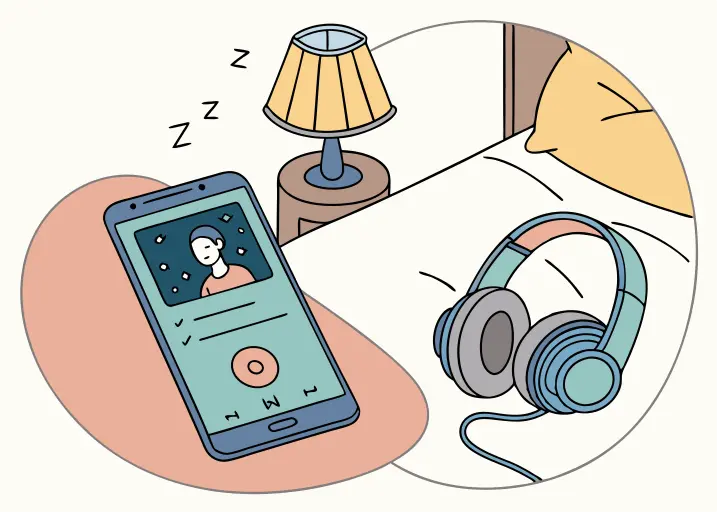
Your Path to Better Sleep Through Music
The scientific evidence strongly supports the use of carefully selected music for promoting deep sleep and improving overall sleep quality. From classical compositions to nature sounds, binaural beats to ASMR, numerous musical approaches offer proven pathways to better rest.
Success with sleep music requires patience, experimentation, and consistency. Start with scientifically-proven categories like classical music, ambient soundscapes, or nature sounds, then gradually refine your selections based on personal response. Remember that the benefits of sleep music often build up over time, with the most significant improvements appearing after several weeks of regular use.
By incorporating evidence-based sleep music into your nightly routine, you’re taking a natural, effective step toward achieving the deep, restorative sleep your body and mind need to function optimally. Whether you choose the gentle waves of ocean sounds, the mathematical precision of 432 Hz compositions, or the timeless beauty of classical music, you’re engaging with a powerful tool that can transform your relationship with sleep and enhance your overall quality of life.
If sleep issues persist despite trying these techniques, consider exploring other factors that might be affecting your rest, such as inflammation and fatigue or blood sugar and energy levels, as these can significantly impact sleep quality and daytime energy.
Remember, quality sleep is foundational to good health, and sleeping music for deep sleeping offers a natural, scientifically-backed approach to achieving the restorative rest your body needs.


